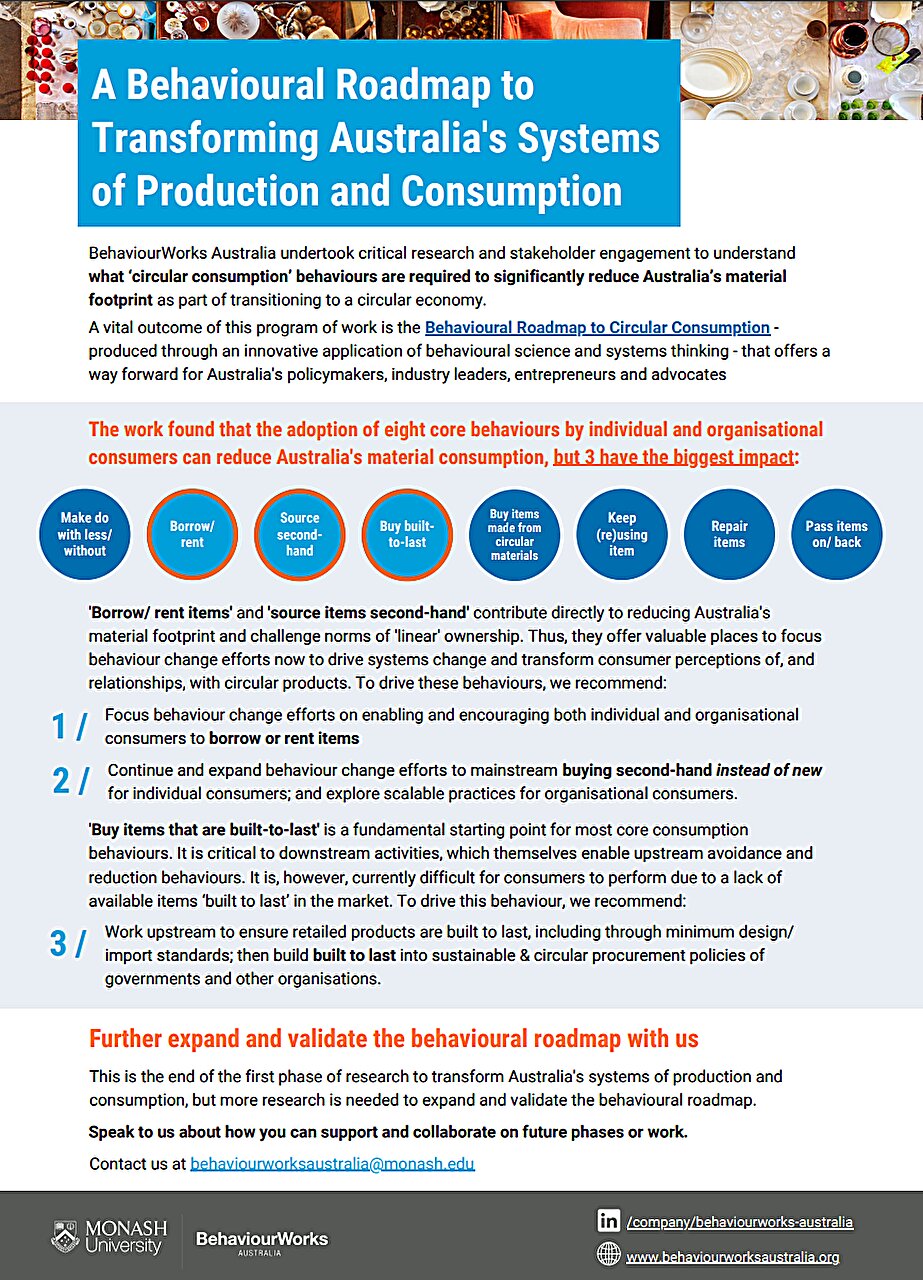The Behavioural Roadmap to Circular Consumption, developed by Monash University’s BehaviourWorks Australia, identifies where policy-makers and industry can intervene in the production–consumption cycle to create change, reduce Australia’s material footprint, and encourage an efficient use of limited resources as the most effective way to confront the ongoing waste crisis.
Different from a Carbon Footprint, a Material Footprint is an indicator of raw material extraction used to meet the final demand of the economy.
Available online, the Behavioural Roadmap sets out connections between all parties, consumers and their behaviors to better understand relationships and influences in the system. Together with the online behavioral system map policy makers can explore these connections to develop or review systemic behavioral public policies that encourage ‘responsible consumption’ and reduce Australia’s material footprint.
Behavioral system mapping is an emerging technique that combines the strengths of two powerful research approaches to produce practical guidance on where and how to intervene to address complex challenges. It then allows the use of behavioral science tools to create the desired change. It uses behavioral science to identify specific actions that different actors can take to address a problem, and systems thinking to understand the connection of these behaviors, highlighting how changes in one part affect changes in another.
Lead researcher Jennifer Macklin said the connections are between consumers and other stakeholders in the system such as designers, producers, importers, retailers, service providers, as well as government and the civil sector.
“The point is that we’re not just placing responsibility on consumers, but looking at the roles of everyone in the production and consumption cycle,” said Macklin.
“It’s the first time policy makers have a tool that highlights the behaviors with the most transformation potential in order to achieve a circular economy.
“The Behavioural Roadmap highlights eight core circular behaviors as options consumers and policy makers could adopt to help reduce Australia’s material footprint, including three key places that policy makers can intervene to speed up the transformation of the whole-of-production and consumption system.”
- Borrow/rent item or service: Focus new behavior change efforts on enabling and encouraging both individual and organizational consumers to borrow or rent items instead of buying.
- Source item second-hand: Continue and expand behavior change efforts to mainstream “buying second-hand instead of new” for individual consumers; and explore scalable practices for organizational consumers.
- Buy items built to last: ensure retailed products are built to last, through minimum design/import standards; then include ‘built to last’ into sustainable and circular procurement policies of organizations.
“The impact of consumer demand on product choice is well known but a change at any stage of the supply chain can also influence customer action beyond simply what products are placed on the market.
“Third-party service providers and community organizations can also influence consumers, while government and civil society can also have a direct, and indirect impact respectively on all stakeholders,” said Macklin.
Citation:
New behavioral system mapping shows key consumer behaviors needed to achieve a circular economy (2023, September 8)
retrieved 8 September 2023
from https://phys.org/news/2023-09-behavioral-key-consumer-behaviors-circular.html
This document is subject to copyright. Apart from any fair dealing for the purpose of private study or research, no
part may be reproduced without the written permission. The content is provided for information purposes only.
Denial of responsibility! TechCodex is an automatic aggregator of the all world’s media. In each content, the hyperlink to the primary source is specified. All trademarks belong to their rightful owners, and all materials to their authors. For any complaint, please reach us at – [email protected]. We will take necessary action within 24 hours.

Jessica Irvine is a tech enthusiast specializing in gadgets. From smart home devices to cutting-edge electronics, Jessica explores the world of consumer tech, offering readers comprehensive reviews, hands-on experiences, and expert insights into the coolest and most innovative gadgets on the market.


